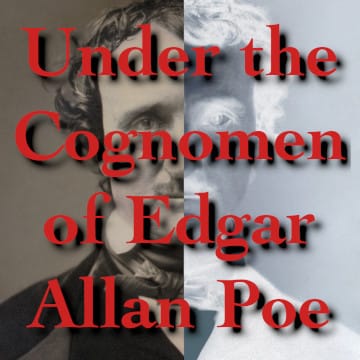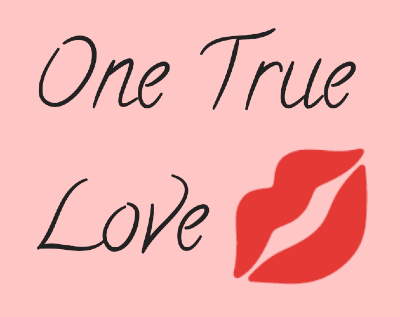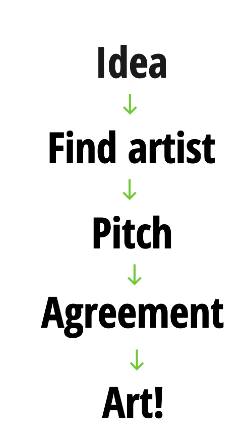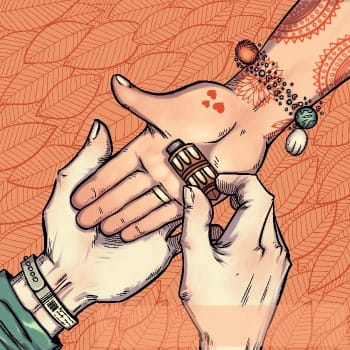The Creative Process #36 - A Guide To Commissioning Art
This is a guide to commissioning art, especially for IF Comp authors.

This month's newsletter is a little change of tack. It's a few months before IF Comp where budding entrants might want to organize some cover art for their game. Many IF writers are not artists. That's okay - getting an artist to make some art for you is a fun and unique process. This post is about how to go about it.
I've commissioned art a number of times before: for IF Comp, for projects I didn't get off the ground, and also just for funsies. I wouldn't consider myself a visual artist, although I'm learning. While some minimal language and understanding from visual art helps, it's not mandatory.
Alternatives
It would be remiss of me to not first mention alternatives to commissioning art. Commissioning costs money, and times are tough. These alternatives make different trade-offs.
Do It Yourself
For something like cover art for a game, you can easily make something yourself. As a starting point, you can take your title and put it in a nice font. If you need fonts, there are very many available for free on places like Google Fonts.
The next step up is utilizing art from the public domain or creative commons. These are bits of art that — assuming you check the licence — let you do whatever you like with it. This was the route 4th place winner of IF Comp 2024 Jim Nelson did for his game Under The Cognomen of Edgar Allan Poe. He took a public domain image of Poe, put a simple negative filter on one half of the image, some text on top with a drop shadow for contrast, and it's done. It's a nice way to capture the theme of "dual personas" from the game and it's memorable.

You can use free software like the GNU Image Manipulator Program, which is like Photoshop but doesn't have a hand constantly in your wallet. Other affordable software:
- Inkscape, vector art (so lines and curves rather than pixels)
- Krita, painting program
- Aseprite, pixel art (technically free if you build it yourself from Github, or $20 on Steam)
- Whatever your operating system provides (eg, Paint)
You don't need to get fancy. Just pick a theme from your game, find the simplest way to express that theme and hack something together. Don't overcomplicate it.
I did this for my little SmoochieComp game One True Love. It's about kissing frogs, so I chose a romantic font, put a romantic pink background, used a kiss shape from a Wingdings-like font and rotated it to fit it in (and provide some visual variety). Done!

If the game were a bigger production, I might bring in other core elements: the princess, frogs, fairy tales... But I didn't need to and it gets the point across.
The trade-off for this DIY approach is that instead of money it'll take your time. Hopefully not much time, but if you invest more time in learning and experimentation, it can pay off in the long run. Plus art is fun!
AI Art
Look, this is an modern option. I'll state the trade-offs up-front.
Using AI art gives you a slightly blunt tool for creating what you want, but at a fairly low price. Given the low price you can experiment with a lot of options until you get something you like.
AI tools require you to be a good filter. If you miss obvious details like extra fingers, roads to nowhere, or weirdly placed items, then your art will be as good as your attention to detail. The might be okay in a quick look, but could ultimately be alienating.
You also might not have the control you think you do, or have the generator guide you rather than your own artistic intent. This might be okay, as we'll see later. But AI art often has a "style" partly down to how these things are trained and used. You can try to avoid the style but it's hard to do so completely.
AI art comes loaded with ethical and cultural concerns, many of which you have no control over. There are ethical concerns about how we respect art and artists, but also its use in propaganda and misinformation gives it a certain taint.
If you're making cover art for IF Comp, be aware that the community is extremely allergic to AI art. Some people have a good eye for spotting it (although false positives are not unheard of). If you use it, then you need to make the choice eyes wide open.
All your major AI vendors offer some form of image generation. Google, OpenAI, Anthropic and Midjourney are some primary examples. There are open-source Stable Diffusion generators available, but you need to set it up yourself.
Overall, I don't think I can recommend it, unless for something to privately explore some visual ideas, but then find another path after that.
Cheap commissions
Another alternative that is not as expensive as proper commissions is something like gig work on Fiverr or sites like that. I've explored this option but never commissioned anything through it. Typically it comes down to: you get what you pay for. $5 of art isn't much art, realistically. At minimum wage, it's not much time and time makes art.
Also for cheap commissions, you don't get a lot of control or input because that also costs time.
I really can't recommend this approach, but I can understand people considering it.
Commissioning Art
There's a process of approaching an artist, proposing a commission and then working through it to completion.

Your work is primarily at the start, but you are involved throughout. You should treat it as a friendly but professional exchange. Artists are people not machines, but there's also money involved.
Remember here that the trade-off is your money for their time and expertise. It's a good deal since you mostly pay for time, with a mild premium for expertise.
Get an idea
There's no point pursuing this unless you have some idea what you want. You don't have to have a specific idea for the final product, but general ideas like:
- A specific scene or an abstraction of the game;
- Themes, genre or colours of the work;
- The basic emotion you want to convey about the game.
Scratch it out on paper, even if you have no drawing skills. Just having a visual representation of a thing you want to bring into the world can help the process. Conversely, some people express their idea as textual description, but without mapping it out, the resulting art might be too busy or even impossible to capture.
Finding an artist
Locating an artist you want to work with is a tricky situation. You will want someone who can do the work you need; a children's book illustrator may not want to do art for dark gothic erotica. Ideally they'll be in your time zone, so you can have productive discussions rather than playing email tag with daily lags.
Ideally you'll see artists in your social media feeds and follow them for a while, to get an idea of their work and schedule.
If you're part of a small community like the Interactive Fiction Community forum or a game dev Discord, then it can be worthwhile to put out a general call to see who might be interested.
Conversely, I think it's unwise to put out a general call on social media. With such a wide net, you're bound to get scammers, bots and all sorts of inappropriate responses. I've tried it and the best result was I got someone whose main art expertise was making eSports logos. They were good at that, but that's not what I needed.
Other places to look are portfolio sites — individual or for things like clubs or schools. I found some sites dedicated to Australian illustrators that linked to a number of artists' portfolio.
At the end of this process, have a short list of 2-4 artists you might want to approach and an ordering. This usually takes me a session or two. I recommend writing down exactly why you think they would be good for your project, just so you can better prepare for the next stage.
Making an approach
Go through your list of potentials and approach them one-by-one. Probably don't blanket them all in a single email. I find the professional relationship works better if you approach them one at a time, moving onto your next option if it falls through.
Don't worry if you can't get your favourite. Good artists are often busy artists, and the timing might not be right. Some of my favourite artists have commission backlogs for months or even years.
Artists often have a way to request commissions through their portfolio, if they are taking any. Otherwise a DM on social media may work.
If they don't have a direct commissions method, it's worthwhile asking first. Just a simple: "Do you take commissions and would you be available for one in this timeframe?" Don't tease it out in piecemeal messages. Get permission to pitch to them, and then make a strong, complete pitch.
Important details for the artist:
- What art do you want made? This could be cover art, title page art, decorations for your game, character portraits... Be specific. Adjectives that can matter:
- Static or animated
- Linework or no linework
- Colour or black-and-white
- Character/s or not
- Just a face, a bust shot or a full body
- Action scene or just a pose
- Any text
- When do you need it? Give specific deadlines for completion.
- What style are you looking for? Compare illustrated, painted, digital illustration, comic art, manga, realistic...
- What form do you want it in? Dimensions of the art, file format, and how many images, for example.
- What are we doing with this art? If you're including it in a game to sell, this can sometimes be markedly different than if you're just including it on a website or in a competition. Think commercial use vs personal use.
- What's your budget? Be honest and realistic about this. If they have commission prices on their website, use that as a guide (and use the same language so you know you're talking about the same thing).
- Why did you choose this artist? Pointing to specific items in their portfolio as inspiration can help enormously.
- Have you got any experience in commissioning artists? It helps being honest in whether you are feeling out this process, or know exactly what you want.
All of this is to give the artist a sense of scope of the project. They'll need that to explain the cost and timeline. It is important to be constrained and realistic on what you want. Perhaps frame it mentally as the Minimum Viable Solution to your art problem: what art do I need to achieve the effect I want?
As an example, here's my cover art for my IF Comp 2023 game:

Details I included in my pitch:
- I needed just a cover art for IF Comp (included link to other examples).
- I wanted a square 700x700 colour PNG, with space for the game's title.
- I had a timeline of 2-3 months until IF Comp.
- A single line description of the game it was going to be associated with.
- The image needed to have unlimited free distribution because of the competition.
She didn't have explicit pricing on her site because it's a function of complexity, so I asked about rates rather than discussing my budget. I had an idea in my head for what I would expect to pay.
Hammering out the details
At this point your chosen artist has said whether they're available and keen. They may have more questions at this point. Respond as clearly and promptly as you can. Chasing the details of a commission for too long can put some artists off.
You might expect a little back and forth as you get the details in line. This may take longer depending on how specific your vision is, and how much input/control you give the artist. I often try to come with a strong vision, but be very flexible if the artist has ideas. Usually the ideas are great and delightful, and matching together on a shared vision is one of the joys of commissioning art, in my experience.
At some point the artist will likely lay out the conditions of the commission. This includes:
- The cost and when payments are required.
- The exact scope of the project
- Estimated timelines
- Copyright conditions
Professional artists often have this as a form that you sign. Be prepared to sign digitally or make the effort to get it sorted by whatever other means you have. A quick signing makes for an early start. No artist wants to be left hanging while you sort out Adobe Acrobat.
This stage will also key you in on how experienced and professional this artist is. Amateurs will say, "Oh that'll be $50 and two weeks", whereas a professional will outline the exact cost (including taxes if applicable) and give you a detailed timeline for initial sketches to final product.
The work begins
Now you wait. You've hopefully signed a contract and paid a deposit, and now the work is with the artist. They may ask even more questions about the work. Don't be afraid to restate what you've mentioned before - they may have many commissions and the specific detail you said before might have been lost in the chaos.
The process often looks like:
- Initial sketches of options
- Decide on an option
- More linework/detail
- Initial colouring
- Final product
There may be a few rounds of each, depending on the project. Many artists will also state limits on this so you're not in an endless cycle of tweaking or experimenting. Always be clear and honest in these cycles. You only get what you ask for.
I'd recommend being patient during this stage as well. Artists are often juggling multiple commissions simultaneously, as well as life. If things start straying too far from the agreed timelines, then feel free to ping them. But they aren't your servant, they are a colleague in this process.
The work ends
All going well, you'll get your final artwork. It's always like a little personal Christmas for me.
Make sure you get the data as soon as you can, and back it up. Don't rely on the artist keeping it perpetually.
It's also good at this stage to ask about credits, if it hasn't been organized already. They may appreciate a link to their portfolio in your game or specific mentions in the credits. Be generous. Never hide the credits or pretend the art is your own creation. I always record the credits in my commissions folder so I have the correct information right next to the actual art.
Hopefully by the end of this you've found a new artist that you like their work and like working with them. You might even find yourself commissioning more art from them in the future!
If you've had experience commissioning art before, let me know how that went. Do you have any extra tips? Any artists looking for commissions at the moment?